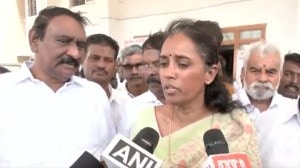A canal runs through it
Some of the large branches of the earlier reaches of the Sardar Sarovar Main Canal and the entire canal systems of the Ken Betwa system in t...

Some of the large branches of the earlier reaches of the Sardar Sarovar Main Canal and the entire canal systems of the Ken Betwa system in the first of the interlinking of rivers project announced with considerable ceremony have a lot in common. Both will serve black cotton and other difficult soils with rainfall which is not scanty, but is erratic and the areas need drainage. They are both serving beautiful areas and like me if you have the time this holiday season, go either to Kevadia in Gujarat or Orchha in MP.
There is another common thread. To the ministry of water resources goes the credit of sharing with the world the Feasibility Report of the Ken Betwa Project. This degree of transparency is unusual and deserves to be applauded and one hopes is the precursor of a faithfully implemented Right to Information Act. Sardar Sarovar was always a transparent project with the over 500-page ‘Planning for Prosperity’ available in the late eighties of the last century and published a little later. Those who criticised it paid it the compliment of never reading it, or ignoring its detail for that would bring them down to real time. But there the similarity between them ends.
The SSP canals are exposing the critics who first said the canal was not possible, and then that water would not flow in it and now that its original design will be impossible. Explaining the Remote Monitoring and Control System now underway, the specialists say it is essential because water is scarce, it is needed in different ways, time is important and anyway we can solve the problem. They put it in expert-ese: “Balancing of the demands and supply and no single solution is applicable to all the 13 different agro-climatic zones”, “the very limited delta of 21” (53 cm) at the head regulator”, “response time far more important considering the distance of source to the farthest delivery point (around 700 km)”, using the “conveyance system for storage also and thereby virtually bringing the reservoir closer to the delivery point. The Narmada Main Canal itself will provide a storage capacity of 209 MCM….”
In the planning phase, they had studied the technologies in other countries, notably France, the US and North Africa and adapted it to Asiatic peasant agriculture. Now the SCP-GERSAR, a French outfit, is supervising a 105 km project for the main canal, 102 km for the Vadodara Branch and some of the smaller branches. The country’s top engineering companies have qualified for bidding for the job and the dream is on the way to becoming the reality of assured, controlled water at the time of need. This kind of covering the last mile will not be possible in traditional designs which flood areas, for example, to grow paddy.
The Ken Betwa Feasability on the internet, it seems, is knowledge proof. The soil scientists did their job as good technocrats. And so, Entisols, 7.3 per cent of the area, “are highly erodible, (and so on) unsuitable for normal crop husbandry. However, they may be utilised for the purposes of forestry, pasture development and growing grasses”, they tell us. In the Plateau soils, 44 per cent of the area, “the shallow soils are unfit for normal crop husbandry whereas deep soils are suitable for growing kharif crops like sorghum, millets, pulses, and bajra.” The Pediment soils, 2 per cent of the area, “The deep soils in this category are fit for cultivation of crops like sorghum, til, bajra, millets and groundnut. Shallow soils are best suited for raising pastures.” The soils of level alluvial plain and undulating flood plain, 43 per cent of the area, ‘‘are best suited to crops like jowar, arhar, soyabean and moong under dry land and sugarcane under irrigated conditions. Wheat, gram and linseed may be grown during the rabi season.” The soils of the dissected flood plains “are severely eroded during floods and need extensive conservation measures. Lands situated away from the streams can be put under cultivation for kharif crops, viz. jowar, bajara and arhar.” The message is that life is complex. Nowhere do they let you grow paddy.
But the feasibility report is of the good old kind, providing for 30 to 40 per cent of the area under paddy or flood irrigation for water requirements of a very heavy kind totally unsuitable for the region. We never learn. There is civil society protest, including by some in a group set up by the WWF.
The Malwa region really needs assured water. The project must go back to the drawing board so that the concept of interlinking doesn’t do any damage. Photo-ops with the famous are no substitute for hard work.






- 01
- 02
- 03
- 04
- 05

























